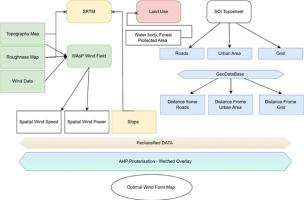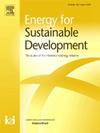MCDM GIS framework for wind energy sites suitability in Algeria's northwest
IF 4.9
2区 工程技术
Q2 ENERGY & FUELS
引用次数: 0
Abstract
To fulfill rising energy demand and slow global warming, countries worldwide are gradually transitioning to renewable energy, including wind power. However, the wind project's success depends on ideal locations, influenced by conflicting feasibility factors, and on balancing energy objectives, costs, and social and environmental concerns. This study proposes a holistic framework for analyzing the complex issues related to wind energy transition solutions using Multi-Criteria Decision-Making (MCDM) methodology, combining geographic information systems (GIS) and the Analytic Hierarchy Process (AHP). To address the optimal wind site selection challenge, this process evaluates sites based on eight feasibility factors, including infrastructural accessibility, technological limitations, and environmental issues. A priority assessment survey was conducted using the expert method. The energy production maximization objectives were mainly based on wind speed and power density data produced using the Wind Atlas Analysis and Application Program (WAsP 12.9) at the regional scale. Overlaying the scores with GIS mapping criteria assisted the sites' classification into five categories, from “unsuitable” to “most suitable”. The proposed MCDM rules, adapted to local conditions, significantly reduced the number of preliminary alternatives by about two-thirds. The regions deemed viable for suitable wind exploitation encompass approximately 1369 km2. The cumulative installed capacity reaches 10 GW, including 4.8 GW in Oran and 1.2 GW in Chlef. Fifteen scenarios were assessed, resulting in an effective capacity of 1.43 GW. The results made it possible to construct a roadmap for wind farms, particularly in northwest Algeria, which may attract the interest of policy makers and industry stakeholders.

阿尔及利亚西北部风能场地适用性的MCDM GIS框架
为了满足不断增长的能源需求和减缓全球变暖,世界各国正在逐步向包括风能在内的可再生能源过渡。然而,风能项目的成功取决于理想的地点,受相互冲突的可行性因素的影响,以及平衡能源目标、成本、社会和环境问题。本研究提出了一个整体框架,利用多标准决策(MCDM)方法,结合地理信息系统(GIS)和层次分析法(AHP),分析与风能转型解决方案相关的复杂问题。为了解决最佳风能选址的挑战,该过程基于八个可行性因素来评估站点,包括基础设施可达性、技术限制和环境问题。采用专家法进行了优先度评价调查。能源生产最大化目标主要基于区域尺度的风速和功率密度数据,这些数据是使用风图集分析和应用程序(WAsP 12.9)生成的。将得分与GIS制图标准叠加,将这些地点分为五个类别,从“不合适”到“最合适”。拟议的MCDM规则根据当地情况进行了调整,将初步替代方案的数量大大减少了约三分之二。被认为适合风力开发的地区约为1369平方公里。累计装机容量达到10吉瓦,其中奥兰4.8吉瓦,克利夫1.2吉瓦。评估了15种方案,有效容量为1.43吉瓦。研究结果使构建风电场路线图成为可能,特别是在阿尔及利亚西北部,这可能会吸引政策制定者和行业利益相关者的兴趣。
本文章由计算机程序翻译,如有差异,请以英文原文为准。
求助全文
约1分钟内获得全文
求助全文
来源期刊

Energy for Sustainable Development
ENERGY & FUELS-ENERGY & FUELS
CiteScore
8.10
自引率
9.10%
发文量
187
审稿时长
6-12 weeks
期刊介绍:
Published on behalf of the International Energy Initiative, Energy for Sustainable Development is the journal for decision makers, managers, consultants, policy makers, planners and researchers in both government and non-government organizations. It publishes original research and reviews about energy in developing countries, sustainable development, energy resources, technologies, policies and interactions.
 求助内容:
求助内容: 应助结果提醒方式:
应助结果提醒方式:


